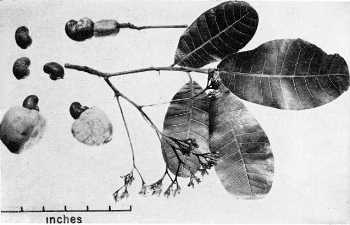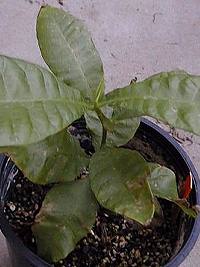Sunset®: 23-24
USDA: 11-12
Frost Tolerance: Tender in Phoenix, foliage damaged at 32° F (0° C), serious damage at 25° F (-4° C)
Sun Exposure: Full sun
Origin: Brazil
Growth Habits: In the tropics, evergreen tree growing rapidly to 20 to 40 feet (6 to 12 m)
Watering Needs: Tolerant of drought, grows much better with regular water
Propagation: Seeds, budding, marcotting

The Cashew, a native of Brazil, is now found throughout the tropical regions of the world, particularly in India. The tree grows rapidly, reaches a height of 20 to 40 feet, and may bear in 2 years from seed. The leathery, alternate, obovate leaves are 5 to 7 inches long (13 to 18 cm) and are prominently veined. The cashew grows well on a wide range of soil types and is tolerant of drought.
Blooming Habits:
The small, fragrant pinkish flowers are produced in terminal panicles in March and April. The fruit is unusual in that the kidney-shaped nut, the true fruit, is borne on a greatly enlarged, fleshy receptacle. This structure, the cashew apple, is about 2 inches in diameter (5 cm) and 3 to 4 inches in length (7 to 10 cm). At maturity, approximately 3 months after flowering, the fruit turns bright yellow or red. The acid, aromatic juice is used to make wine and jelly. It can also be used to make a refreshing drink and is reported to be an excellent source of vitamin C. The tree, however, usually is grown for the edible nut. The shell contains an oil that is highly irritating to the skin, and the nuts should be heated to render the oil less toxic before the kernels are extracted. Since the caustic oil is expelled from the shell during roasting, do not allow the smoke to come in contact with the eyes or skin. The cashew is one of the most delicious of nuts after being roasted and is rich in protein and fat. The oil contained in a spongy layer of the shell, has become of great commercial value.
(Adapted from an USDA miscellaneous publications.)
Culture:
The Cashew likes a soil acid rich in organic matter.
Propagation:
Most of the trees of this species, including those in India which produce most of the cashew nuts of commerce, have been propagated by seeds. Fresh seeds sprout readily. It has been reported however, that select forms can be propagated by budding and marcotting.
Desert-Tropicals is dedicated to provide gardening advice, gardening ideas, and information about flower of all kind for landscape and collections.We try to check carefully the identification of the plants on the illustrations as well as the other information from the page, but occasionally errors do occur. if you notice anything that needs to be changed please contact us.Thanks.
© 1998-2020 Philippe Faucon, All Rights Reserved.
